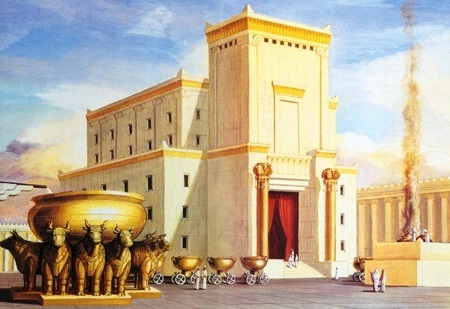
“Make a copper washstand, along with a copper base for it. Place it between the Altar and the Communion Tent, and fill it with water for washing. Aaron and his sons must wash their hands and feet from it.” (Exod. 30:18-19)
Most of the Temple vessels were fashioned from gold and silver. Why was the Kiyor, the Washstand, made out of copper? And why was it placed between the Altar and the Sanctuary?
Preparation before the Avodah
Three metals were used in building the Tabernacle, and later, the Temple in Jerusalem: gold, silver, and copper. Each metal was employed according to its relative value.
Gold, with its great ornamental value, was used to construct the innermost vessels: the Ark, the Table, the Menorah, and the Incense Altar.
Silver is more utilitarian in nature. The sockets which formed the base for the Tabernacle’s beams, the hooks and bands of the courtyard pillars, the wine libation decanters, and other sacred implements, were all fashioned from silver.
Copper, the least valuable of the three metals, was used to make those vessels that were not used in the Temple service itself, but rather to prepare for it. Thus the Washstand, where the kohanim washed their hands and feet before starting their holy service, was fashioned out of copper.
Purifying Thought and Deed
What is the significance of the location of the Washstand? Why was it placed between the Altar and the Sanctuary? And why did the kohanim need to wash not only their hands, but their feet as well?
We serve God in two basic ways:
Washing at the Kiyor purifies and prepares one for both forms of service.
The sanctuary was called the Ohel Moed, the Communion Tent where God told Moses, “I will meet with you” (Exod. 30:6). It was a place of Divine revelation and prophecy. God’s word emanated from the Holy Ark, which held the luchot of the Ten Commandments. This area of the Temple signifies our intellectual service of God through the revelation of prophecy and Torah.
The Altar, on the other hand, was the focal point for elevating the ratzon (the will or primal desire) and deed. The practical aspects of the Temple service were performed around the Altar. Offerings brought on the Altar served to refine the faculty of ratzon — they were to be “לִרְצֹנוֹ לִפְנֵי השם” - “for a desire [that is pleasing] before God” (Lev. 1:3).
The Washstand prepared the kohanim for their holy service on both levels: thought and deed. It was situated between the Sanctuary and the Altar, as both forms of Divine service require appropriate preparation so that they will be performed in purity.
The hands and feet symbolize these two faculties. Our hands follow the dictates of the mind, while our feet move almost involuntarily, without conscious effort. When the kohanim washed their hands, they purified themselves for their intellectual service of God. And when they washed their feet, they purified themselves for their practical service in action and deed.
(Sapphire from the Land of Israel. Adapted from Olat Re’iyah vol. I, pp. 119-120)





